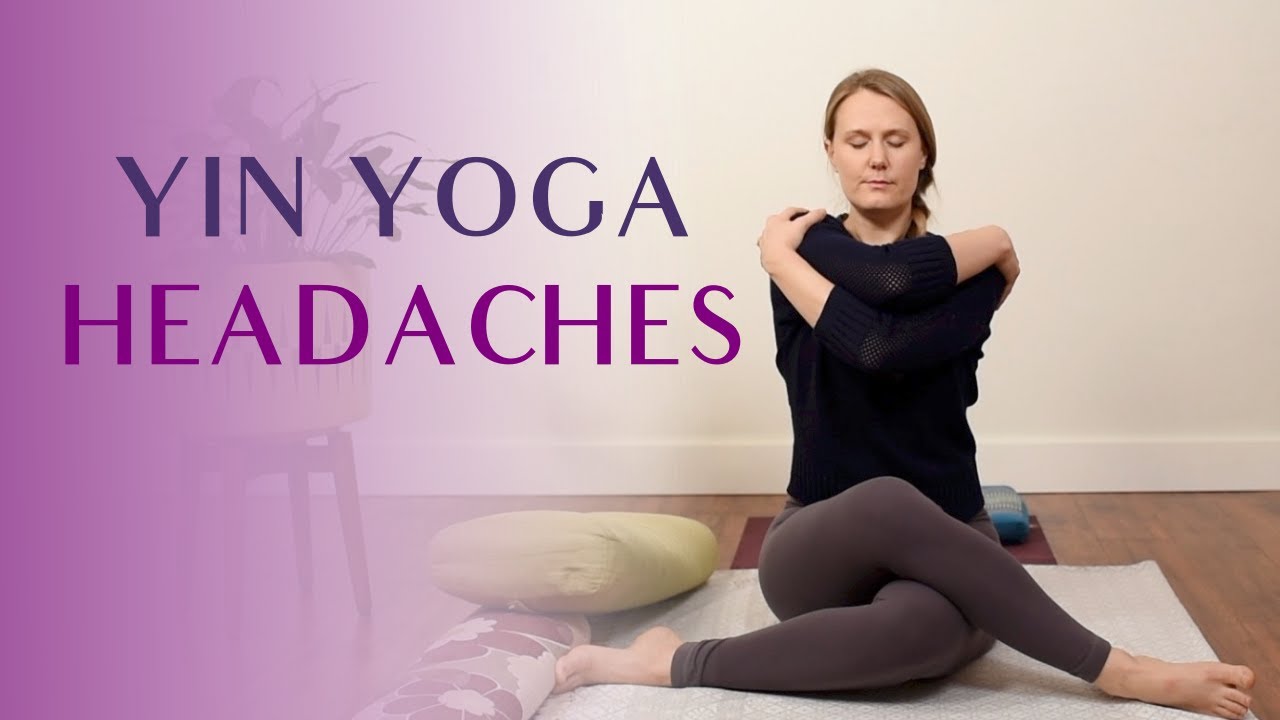This practice is focused on chronic pain from tension headaches but it should help anyone with a pounding head. I’ve used this for over a decade with my class and numerous students have told me how much it’s helped through our targeted practice. The combination of gentle neck and shoulder stretches, along with focused breathing exercises, helps release the built-up tension that often leads to these debilitating headaches. I’ve seen students leave class feeling not only physically better, but also mentally refreshed and more equipped to manage stress in their daily lives.

- Child’s Pose. Kneel and sit back on your heels, extending arms forward. This pose relieves tension in the neck and shoulders. For those with tight hips, place a folded blanket between your buttocks and heels to ease the stretch.
- Cat-Cow Pose. Move between arching and rounding the spine while on hands and knees. This improves spinal flexibility and releases neck tension. For sensitive wrists, come down to your forearms instead of hands.
- Standing Forward Bend. Fold forward from the hips, letting head and arms hang. This pose increases blood flow to the head. If hamstrings are tight, bend knees generously to avoid straining the lower back.
- Legs-Up (the-Wall Pose. Lie on your back with legs extended up a wall. This gentle inversion can help relieve headache pressure. Those with lower back issues can place a folded blanket under the hips for support.
Affirmation: I release tension and invite healing energy into my body. With each breath, my headache fades and peace flows through me
When setting up for a tension headache relief practice, ensure you have props like blocks (or a rolled-up towel) and blankets available to support gentle restorative poses. This practice is meant to be gentle and relaxing, not intense or strenuous, listen to your body throughout the session. Focus on incorporating slow, aware movements and breath work, particularly targeting the neck, shoulders, and upper back areas where tension often accumulates. After your practice, continue to practice deep breathing techniques and gentle neck stretches at home, and remind them to stay hydrated and maintain good posture throughout their day to help prevent future tension headaches.
8 Likes
Deepen Your Practice Beyond the Mat
Finding meaningful yoga discussions and guidance can be surprisingly difficult. Discover a space where your questions are welcomed and your growth is celebrated: Start Your Journey
It’s needed to maybe look at your diet too. Foods high in magnesium, like almonds and spinach, can naturally help ease tension headaches.
Yoga works the best when you let it work with your body and that means taking a complete approach to take care of yourself 
Dehydration makes every headache worse so sipping room temperature water between poses actually helps the fascia release better than chugging cold water after! Hell, do both.
I started bringing two water bottles to class, one warm with lemon for sipping during gentle twists, one cold for after. The warm water thing sounds weird but my physical therapist explained how it helps the tissue glide better, especially around those tight trap muscles.
Please know that certain poses like headstands and other inversions may actually make your discomfort worse by creating additional pressure in your already aching head. Instead, I encourage you to embrace gentle, restorative poses and soft, flowing movements that can truly nurture your body and ease your pain. Your well-being matters, and choosing the right approach can make all the difference in finding the relief you deserve.
After years of practicing these poses, adding gentle jaw releases between movements made an incredible difference, turns out my tension headaches were connected to clenching my jaw during stressful times! Now I always incorporate manual jaw massage during Child’s Pose, gently working the muscles around my temples and jaw while breathing deeply. This combination of the yoga sequence with targeted jaw work has reduced my headache frequency by at least 90%, especially when I check in with my jaw tension throughout the day.
While I appreciate the cooling effects of Sheetali breath, I’ve actually found that in tropical climates, the humidity might not be the primary culprit for tension headaches, it could be the constant temperature fluctuations between air-conditioned spaces and the outdoor heat.
Instead of focusing solely on cooling pranayama, alternating between warming breaths like Bhastrika and then cooling techniques creates a more balanced approach. Plus, not everyone can roll their tongue for traditional Sheetali, so Sheetkari breath (inhaling through clenched teeth) might be more universally accessible and equally effective for that cooling sensation and tension release.
My evening practice has been so much more effective than morning sessions for my tension headaches, it’s because I’m releasing the entire day’s accumulated stress from my upper back, not just my neck and shoulders!
I started incorporating those deep rhomboid stretches between the shoulder blades, since that’s where I unconsciously store tension while hunched over my computer. There’s a sequence that targets exactly that spot while using breathwork to release the fascia, and it’s completely changed how I approach headache relief. The practice flows from upper back releases into neck work, addressing the whole chain of tension rather than just where we feel the pain.
Have you tried adding the Bridge Pose? It gently opens the chest and shoulders, reducing upper body tension, which is vital for headache relief.
Ever wonder if your headaches are just your brain’s way of saying, ‘I need a vacation’? Maybe try a Downward Dog and pretend it’s a beach chair!

